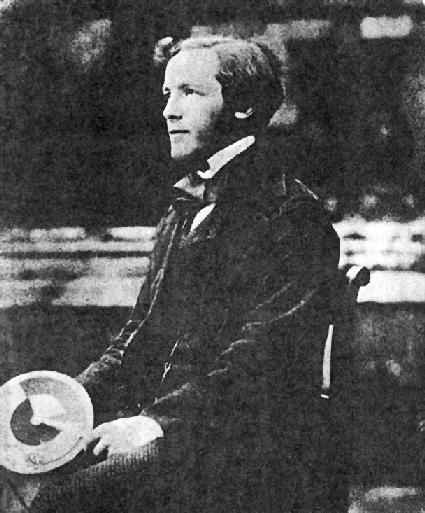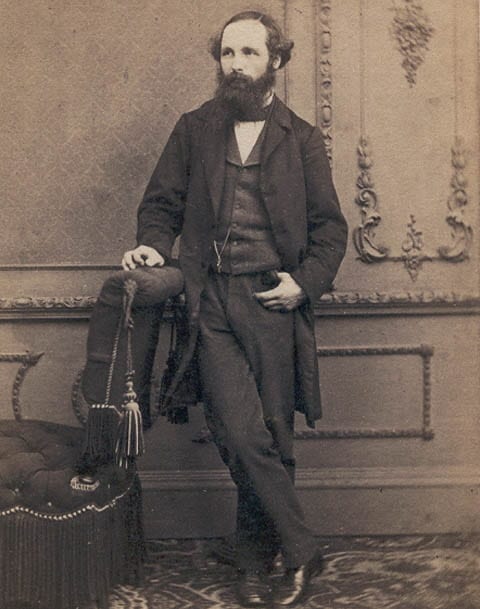
Hey, is that James Clerk Maxwell? HAPPY BIRTHDAY, James Clerk Maxwell (13 June 1831 — 5 November 1879)!
There’s just something about the people like James Clerk Maxwell and their crazy beards. It’s like a birds’ nest for your chin!
So, Jimmy Max here is a pretty important dude. James was a theoretical mathematician and physicist – If you’ve ever heard of or practiced the modern electromagnetic theory, you have heard of James Clerk Maxwell. Many people consider James as important as Albert Einstein and Michael Faraday – besides his big ol’ brain, I’m jealous of his amazing chin coiffure. GO BEARDS!
Jimmy Max’s life was quite interesting. He was home schooled by his mother, he got tired of his toys when he was 6 or 7 and started playing with reflecting plates of metal and studied frogs’ life cycles, and unfortunately his mom died after an operation when he was 8. James was raised by his dad and sister-in-law Jane, educated by an unknown 16-year old boy who treated James like a bother. Since James was raised on his father’s country estate in solitude most of the time after his mother’s death, his school experiences were apparently harsh and full of ridicule. James was more intelligent than his teachers and fellow students, which also probably didn’t help things much.
James’ scientific career began pretty early. From Wikipedia:
Maxwell was fascinated by geometry at an early age, rediscovering the regular polyhedron before any formal instruction. Much of his talent went unnoticed however, and, despite winning the school’s scripture biography prize in his second year, his academic work remained unremarkable, until, at the age of 13, he won the school’s mathematical medal, and first prizes for English and poetry.
For his first scientific work, at the age of only 14, Maxwell wrote a paper describing a mechanical means of drawing mathematical curves with a piece of twine, and the properties of ellipses and curves with more than two foci. His work, “Oval Curves”, was presented to the Royal Society of Edinburgh byJames Forbes, professor of natural philosophy at Edinburgh University, Maxwell deemed too young for the task. The work was not entirely original,Descartes having examined the properties of such multifocal curves in the seventeenth century, though Maxwell had simplified their construction.
In addition to, you know, developing the theory of electromagnetism, James Clerk Maxwell developed some other pretty interesting scientific developments. From above, his work with geometry and multi-focal curves lead to developments in optics and color vision. One area that I found particularly interesting was his work with photographic images and color. A photograph of a tartan ribbon was taken three times with the first single-lens reflex (SLR) camera developed by Thomas Sutton, each photograph with a different color filter placed in front of the lens – red, blue, and green. Then, by projecting each of these colored images on top of one another with three separate projectors, James created a full-color image. Check it out:
Another pretty interesting development that James brought about was the Maxwell Disc. James’s color wheel disc was very similar to James Forbes’ spinning color discs – you know, the ones that have three colors on them, and when you spin the disc, the color appears as a single color? James Maxwell’s color disc had three very tuned colors (vermillion red, emerald green, and ultramarine blue). This is a very simple explanation of Jimmy Max’s color wheel top – however, his work helped to develop the 1931 CIE color space. He had his hands in all kinds of stuff!
Maxwell, as a young pup, with his color wheel:

Maxwell’s Color Triangle – look familiar?

Maxwell’s Equations and Electromagnetism
James Clerk Maxwell developed the theory of electromagnetism, and Maxwell’s Equations are the basis of this theory:
- Gauss’s Law
- Gauss’s Law for Magnetism
- Faraday’s Law (for Induction)
- Ampere’s Law (with Maxwell’s Correction)
Classical Electromagnetism, which is these four laws plus Lorentz’ Law (the law that can be applied to make a current-carrying object levitate between two magnetic fields), is what James Clerk Maxwell is credited with developing. Of course others helped in this work, but Maxwell is credited with the bulk of the development.
Have you seen these laws? They are freaking beautiful, especially if you like math like me:
Or, if you like humor:
One last thing – our man James was a poet! He wrote all kinds of poetry, but my favorite was his mathematical poetry. Here’s one for the road:
Energies through the ether flow,
Waves travel to and fro,
And with a ratio
Their speed you measure.
Colours yield their secret hue,
And Saturn’s rings subdued by you
Suggest that gases
Might be measured too.
Science you freed
From cramping mechanistic creed,
And by your theory brought
The elastic solid ether to naught,
And changed the axiomatic basis
Of scientific thought.
Oh Maxwell! How can I declaim
On such a genius, such a fame,
And speak of one so very wise
Who saw the world through splendid eyes,
And though of such a subtle mind
Was yet so humorous and kind?
Yours was a mind unique and rare
That, nurtured in a northern air,
Struck out new paths in many ways
Through all too short, yet fruitful days.
How can one capture in a line
Something so great, so pure, so fine?
Give thanks,
That such a man drew breath,
And lament with all the world
His early death.
Happy Birthday, Jimmy Max!
Thanks Wikipedia, St. Andrews, and Sonnet Software!









